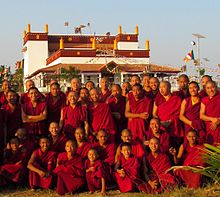Rato Dratsang
| Rato Dratsang | |
|---|---|
 Some of the Rato monks in front of the temple at Rato Monastery, January 2015 | |
| Religion | |
| Affiliation | Tibetan Buddhism |
| Sect | Gelug |
| Leadership | Currently (2015) is Ven. Khyongla Rato Rinpoche |
| Location | |
| Location | Currently in the Tibetan Settlement, Mundgod, Karnataka, India (before 1959 near Lhasa in Tibet) |
| Country | India |
| Architecture | |
| Founder | Tak Pa Zang Bo |
| Date established | 14th century |
| Part of a series on |
| Tibetan Buddhism |
|---|
 |
Rato Dratsang (Dratsang in Tibetan means school or university), also known as Rato Monastery (sometimes spelled Ratö Monastery), is a Tibetan Buddhist monastery or monastic university of the Gelug or "Yellow Hat" tradition. Rato was, for many centuries, one of the major monastic colleges in Tibet.
The 5th Dalai Lama, Ngawang Lobsang Gyatso (1617–1682), called Rato Monastery the "Tiger Nest". The monastery served as a center for the study of logic; monks from many other monasteries came to visit Rato every year to study formal Buddhist logic intensively, and debate rigorously.
After 1959, Rato Monastery was reestablished in the Tibetan Settlement at Mundgod, in Karnataka state in south India. In recent years a charitable foundation (a 501(c)(3) organization) was set up to help the monastery flourish and grow. In 2012, a westerner monk, Nicholas Vreeland, was appointed as the new abbot.[1]
History
Rato Monastery was founded in the 14th century by Tak Pa Zang Bo, on the outskirts of Lhasa, the capital city of Tibet.[2]
During the 17th century, the Great Fifth Dalai Lama called Rato the "Tiger Nest", commenting in verse:[2]
- "In the heart of the dense forest of
- Scriptural knowledge,
- Lies the Tiger Nest sounding
- The roar of the wisdom of logic.
- May the study of logic to clear the minds,
- Forever develop in the boundaries of the upper,
- Middle, and lower parts of the land of snow."
Venerable Khyongla Rato Rinpoche, (born in 1923), who is the head lama of Rato, studied at the original Rato Monastery when he was a young monk. In 1959, before the Tibetan diaspora started, about 500 monks studied at Rato.[2]
After the diaspora had started, in 1983 a small version of Rato Monastery was established in the Tibetan Settlement near Mungod, in Karnataka, India. At that point the monastery comprised a temple, monks' room, and kitchen, all in a two-storey building on one quarter-acre of land. Over time, more land was gradually acquired by being purchased from surrounding farmers. In 2008, a plan was devised for several much larger buildings, using local building materials and low-cost sustainable technologies.[3] As the money was raised, the buildings were gradually constructed.

When Rato Dratsang was first reestablished in Karnataka in India, it was administered as part of the re-established Drepung Loseling monastery, which is in the same area. In the late 1980s, however, Rato was able to become a separate monastery or monastic university.[4]
By 2012, there were about 100 monks in the reestablished Rato Monastery in South India. In May 2012, the 14th Dalai Lama appointed Geshe Thupten Lhundup (Nicholas Vreeland) as the new abbot of the monastery, the first time a westerner had been appointed abbot of a major Tibetan Buddhist monastery.[2] Rato Dratsang is "one of a few important Tibetan Government monasteries under the patronage of His Holiness the Dalai Lama".[5][6] At Rato Monastery, Geshe Thupten Lhundup is now addressed as Khen Rinpoche.[4] "Khen" means abbot in Tibetan, and "rinpoche" is a respectful honorific that is used for high lamas and abbots; it literally means "precious one".
Rato Monastery is featured extensively in the 2014 documentary film, Monk with a Camera.
The Rato Dratsang Foundation
As of 2015, Khyongla Rato is still Rato Monastery's head lama (spiritual teacher). In 1986, he and Ven. Geshe Thupten Lhundup (Nicholas Vreeland), along with some of their friends, created a 501(c)(3) non-profit foundation in order to "generate financial support for the monastery, establish scholarly affiliations with Western centers of higher education, provide for the translation and publication of important writings currently unavailable to English-speaking and Chinese-speaking people, and establish a sister monastic college in the west."[2]
References
- ^ Religious News Services, 8 May 2012, Dalai Lama Appoints Ven. Nicholas Vreeland as Abbot of Rato Monastery in India - First Time Westerner Becomes Head of a Tibetan Monastery [1] Accessed 2014-6-1
- ^ a b c d e Rato Dratsang Foundation website [2] accessed 2014-6-3
- ^ Pradeep Sachdeva Design Associates, Projects, Architecture, Rato Monastery, Mungud, The Re-establishment of Rato Dratsang [3] Accessed 2014-6-3
- ^ a b Website of the Foundation for the Preservation of the Mahayana Teachings, Mandala, Archive, Mandala for 2015, January, Dharma and the Modern World, January–March 2015, "The 'Monk with a Camera': An Interview with Khen Rinpoche Nicholas Vreeland", Accessed 2015.1. 28
- ^ Tasveer Arts, Nicolas Vreeland - "Photos for Rato" [4] accessed 2014-6-3
- ^ Nicholas Vreeland [5] Accessed 2014-6-3
